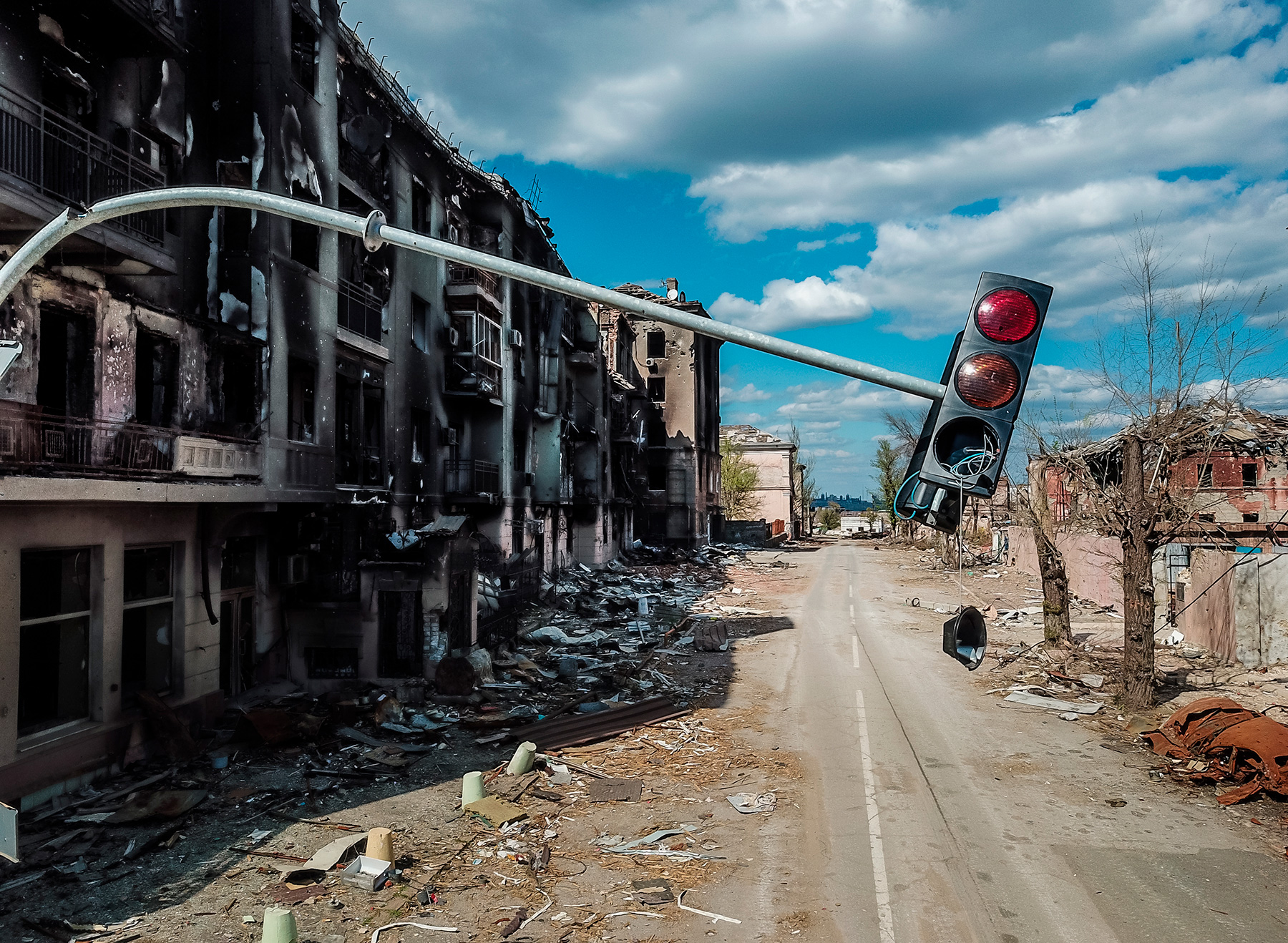In Russia, the point of view that the goal of the United States and the “collective West” headed by Washington is a final solution to the “Russian question” is becoming more and more widespread. Such a goal is seen as defeating Russia, levelling its military potential, restructuring its statehood, rewiring its identity, and possibly liquidating it as a single state. This view remained on the periphery of foreign policy thinking for a long time. The past year and a half has changed a lot. Today, this perception of the West’s goals has become mainstream. It has a stable and rationally reflected character. Russia itself is pursuing an active reciprocal policy towards the Ukrainian state, whose existence in its former form and borders is perceived in Moscow as a key security challenge.
The historical experience of the past century shows that inflicting a total defeat on the enemy, followed by the restructuring of its statehood, is more of a rule of foreign policy practice than an exception.
Despite the expectation of a new crisis, the scenario of a full-scale military operation against Ukraine was considered by many, including Russia, to be unlikely. Russia was deeply embedded in the global Western-centric economy. Trade interdependence with the EU still remained high. There was no value rejection of the West in Russia, although certain social phenomena and movements were criticised and caused a natural compensation by turning to traditional values. For Moscow, the security of the western borders remained a key issue. Apparently, the Russian authorities proceeded from the inevitability of the gradual militarisation of both Ukraine and the eastern flank of NATO, followed by a military crisis at an inconvenient moment for Russia. Neo-Nazism in Ukraine was not widespread and was not widely supported by the population, but the tolerance for radical movements of the Kiev authorities caused categorical rejection in Russia. The decision on a preventive military operation became a point of bifurcation, which radically increased the stakes of rivalry. The subsequent military conflict largely nullified the legacy of the post-Soviet period.
There will be no return to reality of 2021. Obviously, Russia will do everything possible to protect the new territorial status quo, as well as to undermine the military potential of Ukraine as much as possible. It is also obvious that the West will do everything possible to exhaust Russia, and if the circumstances are favourable for it, it will also use internal problems to its advantage.
The question remains, how will the current crisis end? There is currently no political solution to the Russian-Ukrainian conflict. The sustainability of any peace agreement, even if it is reached, is a big question. The West fears a sharp military escalation and a war with Russia, which could quickly turn into an exchange of nuclear strikes. However, NATO’s gradual military involvement in the conflict cannot be ruled out. The prospects for internal unrest in Russia are widely discussed in the Western media and analytical materials. So far, such views are not clearly reflected in official positions. But the transition from expert exercises and populist statements by individual politicians to an official position may only be a matter of time. Trouble in a major nuclear power creates great risks. But in the West, they may be perceived as lower than a direct military clash, and an internal explosion could allow Russia to be taken out of the game for a long time and try to reformat its political system. Under this scenario, Russia’s preservation of its statehood and sovereignty again becomes the main stake of the conflict. The statehood of Ukraine is another stake. It is highly likely that it will come out of the current crisis with an undermined potential, truncated borders, and total dependence on external forces.
In Russia, the point of view that the goal of the United States and the “collective West” headed by Washington is a final solution to the “Russian question” is becoming more and more widespread. Such a goal is seen as defeating Russia, levelling its military potential, restructuring its statehood, rewiring its identity, and possibly liquidating it as a single state. This view remained on the periphery of foreign policy thinking for a long time. The past year and a half has changed a lot. Today, this perception of the West’s goals has become mainstream. It has a stable and rationally reflected character. Russia itself is pursuing an active reciprocal policy towards the Ukrainian state, whose existence in its former form and borders is perceived in Moscow as a key security challenge.
The historical experience of the past century shows that inflicting a total defeat on the enemy, followed by the restructuring of its statehood, is more of a rule of foreign policy practice than an exception. This is the key way in which this differs from the conflicts of the 18th and 19th centuries, when the military defeat of the enemy was seen as a way to get concessions, but not to rebuild the foundations of its statehood.
The experience of the 20th
and 21st centuries is not always linear, but its repetition is obvious. The defeat of Germany in the First World War led to a tangible reshaping of its statehood. It was determined by internal contradictions. But it was completed by the country’s defeat in the war. The defeat of Germany after the Second World War led to much more radical consequences. The country was divided, deprived of autonomy in foreign policy and almost completely rebuilt. The military defeat and subsequent occupation led to the reformatting of other major powers — Japan and Italy. The Soviet Union, as a victorious country, was an active participant in the solution of the “German question”. In the countries liberated from Nazi occupation, the USSR actively created socialist regimes. The subsequent Cold War made such changes difficult. Each such attempt met with resistance from the enemy. Sometimes the fight ended in a draw, as happened in Korea. Sometimes the Soviet Union took over, inflicting, for example, a painful defeat on the United States in Vietnam. On occasion, the United States has been successful in assisting anti-Soviet forces, such as in Afghanistan.
The collapse of the USSR gave Washington a free hand. Despite the rhetoric of the Soviet, and then the Russian side, that the Cold War had ended in victory for both sides, the reality spoke otherwise. The former socialist countries were quickly integrated with the Euro-Atlantic structures with the active assistance of the new local elites and with broad public support. Russia itself declared its desire to return to the “civilized world”. The United States and the West as a whole received a wide carte blanche in the restructuring of a vast space, and not without reason considered it the result of their bloodless victory over the Soviet Union. Without a counterbalance, the US carried out several military interventions, which also ended in a complete restructuring of the target states. Yugoslavia collapsed. Iraq was occupied, its leader executed, and its system of government changed. There were also punctures. In Afghanistan, a quick victory turned into a viscous guerrilla war, which led to the subsequent withdrawal of troops. The military intervention in Iran did not take place, although it was planned. North Korea became a nuclear power, sharply reducing the likelihood of an external invasion. Successful US interventions caused dissatisfaction in Moscow, but until a certain point it did not yield large protests. Inside the country, large-scale Western investments, close humanitarian cooperation, and the interest of Russian society in the West were encouraged or, at least, not condemned until the end of the 2010s.
At the same time, the steady and growing rejection of the Russian authorities was caused by two tendencies. The first was the increasingly tangible attempts on the part of Western countries to engage in dialogue with so-called Russian civil society, bypassing the state. In this paradigm, “good” civil society and “bad” government were opposed to each other. Moscow’s growing and understandable allergy was evoked by the notion of the “Russian regime”. It hinted or even directly indicated that the West somehow sees civil society as opposed to the government and does not consider it part of one political community. The more deliberate and demonstrative this approach was on the part of Western states, the more opposition it generated in Moscow. In the West, the explanation used to justify this approach was that Russian democracy had shortcomings, which only increased irritation in Moscow. The Russian authorities obviously did not want to depend on external assessments of the structure of the state. Moreover, the denominator of such assessments was increasingly set not only by mature democracies, but also by the Eastern European and Baltic countries, with their bouquet of historical grievances and complexes. The experience of “colour revolutions” in the post-Soviet space only strengthened Moscow’s fears. In Georgia, Kyrgyzstan and Ukraine, public protests received full moral, political and even material support from Western countries, while the authorities, on the contrary, were often demonized. The revolutionary change of power, albeit for the sake of democratisation and development, was naturally perceived in Moscow as a challenge. A stable consensus took shape in the Russian elite — state building should and can only be carried out by internal forces. Participation by any external power is unacceptable in any form. Consensus began to form as early as the mid-1990s, and by the end of Vladimir Putin’s first term in office, it had turned into a clear political line.
The second trend, which had a significant impact on the change in Russian views, was associated with the policy of the US and the EU in the post-Soviet space. Russia swallowed integration of the countries of Central and Eastern Europe with Western structures, probably considering them a toxic asset. Contrary to the stereotype common in the West, which attributed to Moscow a desire to restore the USSR, the real goals were far from imperial ambitions. Russia was not eager to take on the huge imperial burden again, feed the local elites and buy the loyalty of the population. It was quite satisfied with the neutrality of the former Soviet republics and even cooperation with the United States in the post-Soviet space, provided that such interaction is conducted on an equal basis.
In the early 2000s, Moscow did not object to the American military presence in Central Asia, and then for a long time helped to supply the Western units in Afghanistan. However, Moscow was categorically dissatisfied with the prospect of Western projects without Russian participation. As Vladimir Putin actively pursued a policy of building constructive relations with the US and the EU in all respects, there was hope that the post-Soviet space would remain a neutral field of cooperation. However, it gradually became clear that there would be less and less inclusiveness towards Russia. The “colour revolutions” were another wake-up call. The growing concerns of the Russian leadership were discussed, but each time they were politely dismissed by its Western partners. Apparently, the West simply did not see the need to take Russia’s interests into account. After a total recession in the economy, a large-scale brain drain, a series of internal conflicts, rampant crime, corruption, capital flight and the final completion of the transition to the status of a raw material appendage (which began under Leonid Brezhnev), a decline in the birth rate, rising alcoholism, and sobering mortality rates, it was difficult for Russia to be perceived as a serious competitor. The small-town interests of the elites of some post-Soviet countries, who earned political capital by selling the “Russian threat” to the West, also played their role.
Underestimating the will of the Russian leadership to restore statehood and prevent a zero-sum game in the post-Soviet space was a major miscalculation. With each new crisis, the West did not take into account the realistic worst-case scenarios in which Russia would defend its interests by force, playing a counter-game to reform the post-Soviet states. The first serious crisis was the five-day war with Georgia, during which the Russian side not only responded harshly to the attack against the peacekeeping contingent, but also recognised the independence of Abkhazia and South Ossetia. The West showed far-sightedness, admitting by default the mistakes of the Georgian leader and squaring up the crisis with Russia. But the price was the precedent of the actual revision of borders. Following another Ukrainian revolution in 2013-2014, Moscow quickly responded with a “Crimean spring” and then support for the resistance in the Donbass. The Minsk agreements left the possibility of a relatively soft exit from the crisis. However, Russia’s tough and resolute line had already caused alarm in the West. Here the path was chosen to contain and counteract Moscow. Relations between the West and Russia in the post-Soviet space, and especially in Ukraine, finally entered rivalry mode, and later, the Minsk agreements would be openly called by some Western leaders a maneuverer to prepare for a new fight. Russian support for the Syrian government showed that Moscow would prevent “social engineering” outside the post-Soviet space.
Despite the expectation of a new crisis, the scenario of a full-scale military operation against Ukraine was considered by many, including Russia, to be unlikely. Russia was deeply embedded in the global Western-centric economy. Trade interdependence with the EU still remained high. There was no value rejection of the West in Russia, although certain social phenomena and movements were criticised and caused a natural compensation by turning to traditional values. For Moscow, the security of the western borders remained a key issue. Apparently, the Russian authorities proceeded from the inevitability of the gradual militarisation of both Ukraine and the eastern flank of NATO, followed by a military crisis at an inconvenient moment for Russia. Neo-Nazism in Ukraine was not widespread and was not widely supported by the population, but the tolerance for radical movements of the Kiev authorities caused categorical rejection in Russia. The decision on a preventive military operation became a point of bifurcation, which radically increased the stakes of rivalry. The subsequent military conflict largely nullified the legacy of the post-Soviet period. There will be no return to reality of 2021. Obviously, Russia will do everything possible to protect the new territorial status quo, as well as to undermine the military potential of Ukraine as much as possible. It is also obvious that the West will do everything possible to exhaust Russia, and if the circumstances are favourable for it, it will also use internal problems to its advantage.
The question remains, how will the current crisis end? There is currently no political solution to the Russian-Ukrainian conflict. The sustainability of any peace agreement, even if it is reached, is a big question. The West fears a sharp military escalation and a war with Russia, which could quickly turn into an exchange of nuclear strikes. However, NATO’s gradual military involvement in the conflict cannot be ruled out. The prospects for internal unrest in Russia are widely discussed in the Western media and analytical materials. So far, such views are not clearly reflected in official positions. But the transition from expert exercises and populist statements by individual politicians to an official position may only be a matter of time. Trouble in a major nuclear power creates great risks. But in the West, they may be perceived as lower than a direct military clash, and an internal explosion could allow Russia to be taken out of the game for a long time and try to reformat its political system. Under this scenario, Russia’s preservation of its statehood and sovereignty again becomes the main stake of the conflict. The statehood of Ukraine is another stake. It is highly likely that it will come out of the current crisis with an undermined potential, truncated borders, and total dependence on external forces.
The US is in a better position. Amid the crisis, it is able to discipline its allies and its statehood is not in peril. However, the US has already entered into rivalry with China and found itself in a situation of a double deterrence. The victory of Russia and the strengthening of its relations with China will be a big problem for the United States strategically.
First published in the Valdai Discussion Club.







